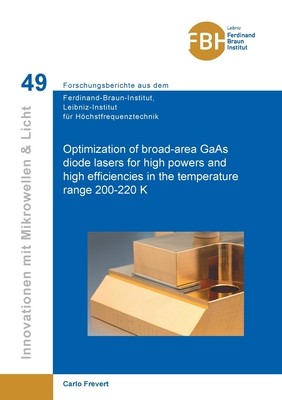
- We will send in 10–14 business days.
- Author: Frevert Carlo
- Publisher: Cuvillier
- ISBN-10: 3736999445
- ISBN-13: 9783736999442
- Format: 14.8 x 21 x 0.9 cm, softcover
- Language: English
- SAVE -10% with code: EXTRA
Optimization of broad-area GaAs diode lasers for high powers and high efficiencies in the temperature range 200-220 K (e-book) (used book) | bookbook.eu
Reviews
Description
This work focuses on the development of AlGaAs-based diode laser (DL) bars optimized for reaching highest powers and efficiencies at low operation temperatures. Specifically, the quasi continuous wave (QCW) pumping of cryogenically cooled Yb: YAG solid-state lasers is targeted, setting requirements on the wavelength (940 nm), the pulse conditions (pulse length 1.2 ms) and frequency (10 Hz) as well as the lowest DL operating temperature THS 200 K, consistent with economic cooling. High fill-factor bars for QCW operation are to reach high optical performance with optical output powers of P 1.5 kW and power conversion efficiencies of ŋE 60% at these power levels. Understanding the efficiency-limiting factors and the behavior at lower temperatures is necessary to design these devices. Optimizations are performed iteratively in three stages. First, vertical epitaxial designs are studied theoretically, adjusted to the targeted operation temperatures and specific laser parameters are extracted. Secondly, resulting vertical designs are processed into low power single emitters and their electro-optical behavior at low currents is experimentally assessed over a wide range of temperatures. The obtained laser parameters characteristic to the vertical design are then used to extrapolate the laser's performance up to the high targeted currents. Finally, vertical designs promising to reach the targeted values for power and efficiency are processed into high power single emitters and bars which are measured up to the highest currents. Eventually, laser bars are fabricated reaching output powers of 2 kW and efficiencies of 61% at 1.5 kW at an operation temperature of 203 K.
EXTRA 10 % discount with code: EXTRA
The promotion ends in 20d.15:34:07
The discount code is valid when purchasing from 10 €. Discounts do not stack.
- Author: Frevert Carlo
- Publisher: Cuvillier
- ISBN-10: 3736999445
- ISBN-13: 9783736999442
- Format: 14.8 x 21 x 0.9 cm, softcover
- Language: English English
This work focuses on the development of AlGaAs-based diode laser (DL) bars optimized for reaching highest powers and efficiencies at low operation temperatures. Specifically, the quasi continuous wave (QCW) pumping of cryogenically cooled Yb: YAG solid-state lasers is targeted, setting requirements on the wavelength (940 nm), the pulse conditions (pulse length 1.2 ms) and frequency (10 Hz) as well as the lowest DL operating temperature THS 200 K, consistent with economic cooling. High fill-factor bars for QCW operation are to reach high optical performance with optical output powers of P 1.5 kW and power conversion efficiencies of ŋE 60% at these power levels. Understanding the efficiency-limiting factors and the behavior at lower temperatures is necessary to design these devices. Optimizations are performed iteratively in three stages. First, vertical epitaxial designs are studied theoretically, adjusted to the targeted operation temperatures and specific laser parameters are extracted. Secondly, resulting vertical designs are processed into low power single emitters and their electro-optical behavior at low currents is experimentally assessed over a wide range of temperatures. The obtained laser parameters characteristic to the vertical design are then used to extrapolate the laser's performance up to the high targeted currents. Finally, vertical designs promising to reach the targeted values for power and efficiency are processed into high power single emitters and bars which are measured up to the highest currents. Eventually, laser bars are fabricated reaching output powers of 2 kW and efficiencies of 61% at 1.5 kW at an operation temperature of 203 K.


Reviews